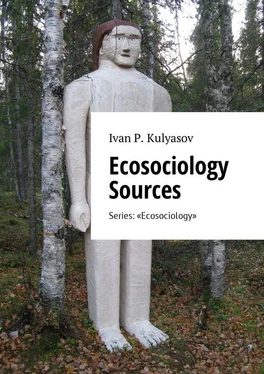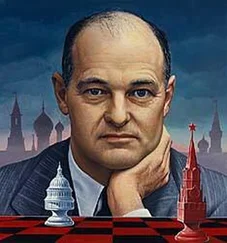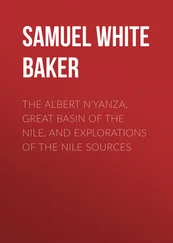I. Kulyasov - Ecosociology Sources. Series - «Ecosociology»
Здесь есть возможность читать онлайн «I. Kulyasov - Ecosociology Sources. Series - «Ecosociology»» — ознакомительный отрывок электронной книги совершенно бесплатно, а после прочтения отрывка купить полную версию. В некоторых случаях можно слушать аудио, скачать через торрент в формате fb2 и присутствует краткое содержание. ISBN: , Жанр: Прочая научная литература, на английском языке. Описание произведения, (предисловие) а так же отзывы посетителей доступны на портале библиотеки ЛибКат.
- Название:Ecosociology Sources. Series: «Ecosociology»
- Автор:
- Жанр:
- Год:неизвестен
- ISBN:9785449009913
- Рейтинг книги:5 / 5. Голосов: 1
-
Избранное:Добавить в избранное
- Отзывы:
-
Ваша оценка:
- 100
- 1
- 2
- 3
- 4
- 5
Ecosociology Sources. Series: «Ecosociology»: краткое содержание, описание и аннотация
Предлагаем к чтению аннотацию, описание, краткое содержание или предисловие (зависит от того, что написал сам автор книги «Ecosociology Sources. Series: «Ecosociology»»). Если вы не нашли необходимую информацию о книге — напишите в комментариях, мы постараемся отыскать её.
Ecosociology Sources. Series: «Ecosociology» — читать онлайн ознакомительный отрывок
Ниже представлен текст книги, разбитый по страницам. Система сохранения места последней прочитанной страницы, позволяет с удобством читать онлайн бесплатно книгу «Ecosociology Sources. Series: «Ecosociology»», без необходимости каждый раз заново искать на чём Вы остановились. Поставьте закладку, и сможете в любой момент перейти на страницу, на которой закончили чтение.
Интервал:
Закладка:
Subsequently, conservationists were blamed for a number of antihuman and antisocial ideas, for example, the idea proclaiming the need to stabilize the planet’s population and even decrease it to one billion or less. In the second half of the 20 thcentury, the corresponding conservationist solutions, ranging from economic stimulation of birth control in China to forced sterilization in India, were made at the national states level. In the beginning of the 21 stcentury, conservationist “greens” push for a ban on industrialization and technical development of third countries (construction of power plants and manufacturing enterprises) and a radical shut-down of the already operating enterprises in the developed countries, paying no attention to the economic conditions and social consequences of their proposals.
The environmental movement, a trend within biocentrism, defended preservation of wild nature, which, in their opinion, has a value of its own irrespectively of its utilitarian use. For example, in 1872, the United States biocentrists established the public organization Sierra Club 8 8 In the early 2000s, Sierra Club and its local branches unite more than half a million members and enjoy the support of an even greater number of volunteers, the media, experts and lawyers, as well as of municipalities, the government and its bodies in charge of environment protection.
. Their views were based on a romantic understanding of nature. They introduce the social into Mother Nature, which is viewed as a perfect creation with spiritual qualities that encapsulates all things living and rational.
Biocentrists view the human life in nature as a certain mode of being and type of behavior, when protection of nature and rational use of natural resources may be just an external manifestation of in-depth motives and value-related orientations. Subsequently, the supporters of this ecological public movement have done a lot to preserve wilderness. Together with industry experts and the government, they developed a natural reserve concept, and such reserves were selected and formally established.
Today we can find a huge number of international, national, regional and local public organizations and civil initiatives for environment protection 9 9 Kulyasov I.P. Environmental movement. Series “Ecosociology”. Russia: Publishing Solution. 2016. 286 p. (in Russian)
. Among themselves, they interact as networks or as partners in specific projects. Older large organizations retain a hierarchic structure. They are supported by local informers, who report violations of the environmental legislation or ecological emergencies. After that, the media and lawyers, responding to petitions filed by individuals or organizations. Where laws need to be amended, volunteers or social networks are used to gather a large number of signatures. At a “quiet” time, environment protection non-governmental organizations provide ecological trainings, raise public awareness, organize and conduct ecological holidays and festivals, various ecological events.
Worldwide and local activity of public environment protection organizations is quite significant and includes managing territories other than fit in administrative boundaries, for example, forests certification of the Forest Stewardship Council (FSC), wetlands and marshes of the International Union for Conservation of Nature and Natural Resources (IUCN), eco-regions of the World Wide Fund for Nature (WWF), and virgin forests of Greenpeace.
Advocates of ecologism were typically represented by researchers who were building scientific models of interaction between society and the natural environment based on consistent patterns of natural sciences, i.e., on ecology. They were using an ecosystem approach implying that individuals, local communities and the humanity in general must be optimally fit into the ecosystem, look after its wealth, ensure an optimal functioning, and prevent crises and catastrophes, including those of a planetary scale.
In this view, the main role of the humanity on this planet is to preserve a dynamic balance of ecosystems and biological diversity. Ecologists combined features typical for the conservationism shown by the government bodies in charge of environment protection with the biocentrism of the environmental protection movement.
The purpose of the American Environmental Society, established in 1915, was studying ecosystems, including human communities. Another very important goal related to promotion of this knowledge and its inclusion in educational programs. The third goal was reforming the American society to turn it into a model of socio-ecological development.
Frederic Edward Clements (1874—1945) believed that the notion of culminating points was applicable not only to biological but also to social systems 10 10 Clements F.E. Nature and structure of the climax // Journal of Ecology. 1936. Vol. 24. №1. p. 252—284.
.
Aldo Leopold (1887—1948) proposed three main socio-ecological ideas that remain relevant until today. The first idea was the notion of an ecosystemic holism. Leopold believed that “ …a thing is right when it tends to preserve the integrity, stability and beauty of the biotic community. It is wrong when it tends otherwise ” 11 11 Leopold A. A sand county almanach and sketches here and there. New York: Oxford University Press. 1949. Vol. 13. 240 p.
.
An ecosystem, which incorporates a social system, becomes emergent, developing new qualities characteristic of a socio-ecological system in addition to the sum of its earlier qualities. Given the contextual and unpredictable nature of the ecosystem, its vitalism cannot be fully cognizable. The social, where it correctly interacts with abiotic and biotic items, structures and communities, leads to an optimal result of evolutionary development – the culminating point of dynamic equilibrium. Disruption of an ecosystemic equilibrium can only lead to degradation of such system.
Ecosystemic holism advocated by ecologists is useful in analyzing the kind of impact on given species and population, general development trends of the natural environment rather than a specific action and its consequences. It has the criterion of human rationality and, hence, is not synonymous with the transcendental nature of biocentrists. At the same time, ecologists are not trying to evade the question: How can one reconcile ecosystemic holism with liberalism – the discretion to choose one’s path of development?
This issue is resolved in the ideas of biotic functionalism and a biotic moral community proposed by Leopold. He maintained that a biotic moral community expands application of moral rules and, afterwards, other social institutes to non-human elements of the global ecosystem. The possibility of linking the human and non-human elements is made possible as ecologists assume that the notions of a “symbiosis” and “model of conduct” are functionally equivalent.
As a result, ethics becomes ecological and is presented as a conscious restriction of freedom of action for the sake of life on planet Earth. An ecologically responsible social behavior also implies establishing social institutes for restricting those people who are not oriented to this type of behavior. The human is perceived as the creator of qualitatively new types of environment and biotic communities, therefore, individuals are granted the right of individualism, which the non-human species may enjoy only at the specie population or the entire specie level. This right is based on the human ability to respond to changes in the natural and social environment in a reasonable manner.
The idea of biotic functionalism, enhanced by the idea of changing the man’s role in the biotic moral community, does not assume that an ecosystem as a superorganism (a supersystem) absorbs society (a subsystem). Ecosystemic holism rejects this idea, always preserving the integrity of the socio-ecological system and its emergent quality, when human moral rules allow retaining equilibrium, harmony and productivity of the ecosystem.
Читать дальшеИнтервал:
Закладка:
Похожие книги на «Ecosociology Sources. Series: «Ecosociology»»
Представляем Вашему вниманию похожие книги на «Ecosociology Sources. Series: «Ecosociology»» списком для выбора. Мы отобрали схожую по названию и смыслу литературу в надежде предоставить читателям больше вариантов отыскать новые, интересные, ещё непрочитанные произведения.
Обсуждение, отзывы о книге «Ecosociology Sources. Series: «Ecosociology»» и просто собственные мнения читателей. Оставьте ваши комментарии, напишите, что Вы думаете о произведении, его смысле или главных героях. Укажите что конкретно понравилось, а что нет, и почему Вы так считаете.




![Джеймс Купер - Пионеры, или У истоков Саскуиханны [The Pioneers, or The sources of the Susquehannah]](/books/395797/dzhejms-kuper-pionery-ili-u-istokov-saskuihanny-t-thumb.webp)







